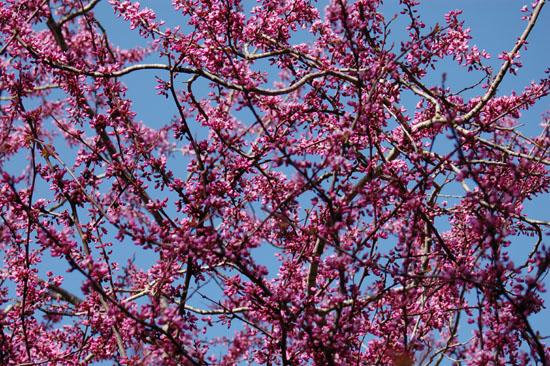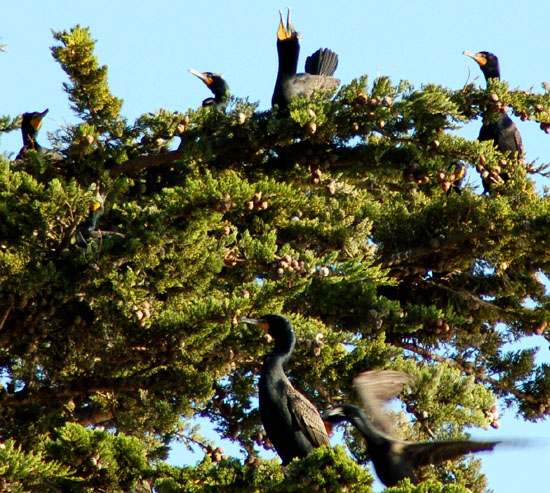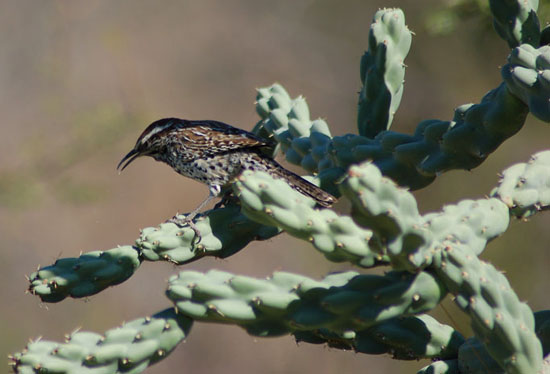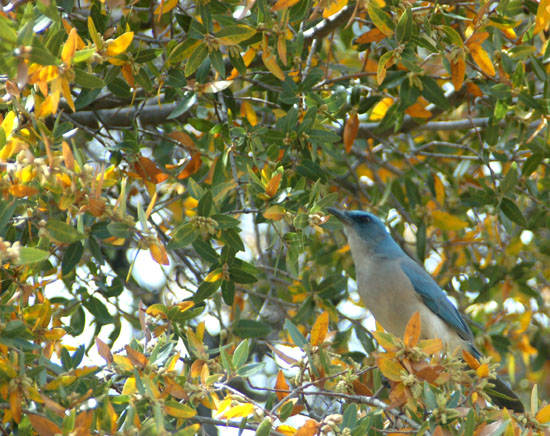As many of you may realize by now, while David and I are avid gardeners, our passion is the gateway to nature that the garden provides. As we arrive in New Mexico, so does spring, with all its chaotic and unpredictable weather. Red buds bloom along with plums, lilacs, and cottonwood. And then it snows, and gardeners and farmers worry about their incipient apricots, cherries, and apples.

As I look out the window, reluctant to venture out into the chilly morning, I muse about the birds that flit among the branches of street trees. Barely visible as they industriously seek their morning fare, I wonder how the birds passed the cold night. Have they built nests and laid eggs yet? My mind meanders to thoughts of Birds and Their Trees.

It seems to me that birds have a very intimate relationship with trees. Trees provide home, security, and often, food. As we travel down the west coast on our book tour, we encounter cormorants nesting in Monterey Cypress (Cupressus macrocarpa) at Pismo Beach on the California Coast. In all the years I have watched cormorants carrying on – in Baja California, in the Pacific Northwest, in Alta California, and even in the bosque along the Rio Grande – I have never seen a nesting colony. We are enchanted. I enjoy the irony that the birds have chosen a semi-urban setting to raise their babies.

In Arizona, as we make our way toward New Mexico, we stop for a late picnic. In the quiet, not too far from the less-traveled blue highway, birds rustle the grasses. We hold still, wondering what might appear. A flicker of brown wings. I slowly raise my binoculars, while David brings his camera to his eye. A bird bursts from the grass and alights in a cholla cactus (Opuntia sp). We are well-acquainted with this bird – a cactus wren – whose life revolves around the sustenance that the cactus provides.

When we cross the border into New Mexico, we are enveloped by an oak-pine forest. Taking a short hike off the road we stop to enjoy the peace of an oak woodland (Quercus emoryi). The leaves twitch with life, but we are not sure what we’ve seen. A flash of blueish gray. A beady eye. A flutter of wings as the bird lands to get a better look at us. This Mexican Jay proves to be a people watcher. Perhaps others have shared their picnic with him. I snap his picture before he tires of us. What is his relationship with the oak? I am sure the Jay loves its acorns. Does he nest among its leafy branches as well?

We pass through the Gila National Forest and we stop at a favorite birding spot. I hear sounds that I recognize. I slice an orange and lay pieces of it on a white-washed stone wall near the trail. We step back into the dense copse. I hold the camera to one eye and watch the forest with the other. We don’t wait long. Our reward for quiet patience arrives. Warily, the Gila Woodpecker approaches the orange slices. He is vigilant in case this is a trap. I snap his picture and he hears the shutter. He pecks the orange slice, and then disappears into the forest. What bird has a more intimate relationship with trees than a woodpecker?
Trees form the backbone of our gardens. They provide the skeletal structure, and these bones invite wildlife to visit. These wild creatures provide invaluable services. Birds, for instance, provide insect control and fertilizer. And if we, in turn, offer shelter and food, we stand to make great gains. We help create healthy habitat; we defragment the eco-system in which we reside, no matter where that is; and we heal our relationship with the natural world.
Do you have a story of trees or birds to share? We invite you to share your stories of the greenworld, and welcome you to join us at one of our stops on the road. See our events page for all the details. If you have a favorite spot we should not miss, please let us know.

Leave a Reply